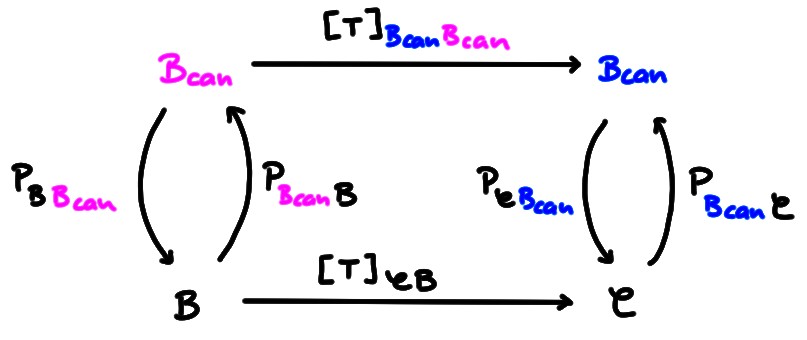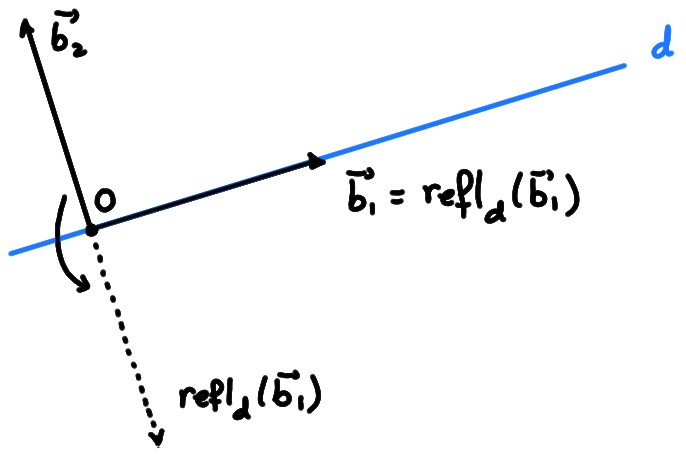8.4 Exemples
Exploitons les diverses formules de changement de base
vues dans les sections précédentes, sur quelques exemples
concrets.
Toutes les applications linéaires que nous avons considérées
jusqu'à présent ont
généralement été définies relativement à la base canonique: leur matrice
s'obtenait en calculant les images des vecteurs de la base canonique.
Mais on sait maintenant exprimer la matrice d'une application relativement à
n'importe quelle base. Nous allons donc repasser par certaines applications
rencontrées précédemment, et étudier leur matrice relativement à des bases qui
ne sont pas canoniques.
Exemple:
Considérons l'application linéaire \(T:\mathbb{R}^3\to\mathbb{R}^2\) définie par
\[ T\left(
\begin{pmatrix} x_1\\ x_2\\ x_3 \end{pmatrix}
\right)
:=
\begin{pmatrix}
2x_2-5x_3\\
x_1+3x_2
\end{pmatrix}
=
\begin{pmatrix}
0&2&-5\\
1&3&0
\end{pmatrix}
\begin{pmatrix}
x_1\\
x_2\\
x_3
\end{pmatrix}
\]
Remarquons que lorsqu'une application est définie de cette façon,
il est implicitement admis que les coordonnées
(ici \(x_1,x_2,x_3\))
sont relativement
aux bases canoniques des ensembles de départ et d'arrivée.
Ici, pour les distinguer, nous noterons temporairement
-
\({\color{magenta}\mathcal{B}_{\mathrm{can}}}=(
{\color{magenta}\boldsymbol{e}_1},
{\color{magenta}\boldsymbol{e}_2},
{\color{magenta}\boldsymbol{e}_3})\) la base canonique de
\(\mathbb{R}^3\),
-
\({\color{blue}\mathcal{B}_{\mathrm{can}}}=(
{\color{blue}\boldsymbol{e}_1},
{\color{blue}\boldsymbol{e}_2})\) la base canonique de \(\mathbb{R}^2\).
Donc la matrice ci-dessus est en fait
\[\begin{aligned}
[T]_{{\color{blue}\mathcal{B}_{\mathrm{can}}}{\color{magenta}\mathcal{B}_{\mathrm{can}}}}
&=
\bigl[
[T({\color{magenta}\boldsymbol{e}_1})]_{{\color{blue}\mathcal{B}_{\mathrm{can}}}}
[T({\color{magenta}\boldsymbol{e}_2})]_{{\color{blue}\mathcal{B}_{\mathrm{can}}}}
[T({\color{magenta}\boldsymbol{e}_3})]_{{\color{blue}\mathcal{B}_{\mathrm{can}}}}
\bigr]\\
&=
\begin{pmatrix}
0&2&-5\\
1&3&0
\end{pmatrix}
\end{aligned}\]
Considérons maintenant les bases \(\mathcal{B}=(\boldsymbol{b}_1,\boldsymbol{b}_2,\boldsymbol{b}_3)\)
de \(\mathbb{R}^3\) et \(\mathcal{C}=(\boldsymbol{c}_1,\boldsymbol{c}_2)\) de \(\mathbb{R}^2\), où
\[
\boldsymbol{b}_1= \begin{pmatrix} 1\\ 1\\ 0 \end{pmatrix}\,,\quad
\boldsymbol{b}_2= \begin{pmatrix} 1\\ 0\\ -1 \end{pmatrix}\,,\quad
\boldsymbol{b}_3= \begin{pmatrix} 0\\ 1\\ 0 \end{pmatrix}\,,\quad
\]
\[
\boldsymbol{c}_1= \begin{pmatrix} 0\\ -1 \end{pmatrix}\,,\quad
\boldsymbol{c}_2= \begin{pmatrix} 2\\ 3 \end{pmatrix}\,.
\]
Calculons la matrice de \(T\) relativement à ces deux nouvelles bases,
\([T]_{\mathcal{B}\mathcal{C}}\).
On peut s'aider du schéma

pour retrouver la formule:
\[
[T]_{\mathcal{C}\mathcal{B}}=
P_{\mathcal{C}{\color{blue}\mathcal{B}_{\mathrm{can}}}}
[T]_{{\color{blue}\mathcal{B}_{\mathrm{can}}}{\color{magenta}\mathcal{B}_{\mathrm{can}}}}
P_{{\color{magenta}\mathcal{B}_{\mathrm{can}}}\mathcal{B}}
\]
Or puisque les vecteurs de \(\mathcal{B}\) ont été donnés en composantes relativement
à la base canonique,
\[
[\boldsymbol{b}_1]_{\color{magenta}\mathcal{B}_{\mathrm{can}}}= \begin{pmatrix} 1\\ 1\\ 0 \end{pmatrix}\,,\quad
[\boldsymbol{b}_2]_{\color{magenta}\mathcal{B}_{\mathrm{can}}}= \begin{pmatrix} 1\\ 0\\ -1 \end{pmatrix}\,,\quad
[\boldsymbol{b}_3]_{\color{magenta}\mathcal{B}_{\mathrm{can}}}= \begin{pmatrix} 0\\ 1\\ 0 \end{pmatrix}\,,\quad
\]
on a déjà
\[
P_{{\color{magenta}\mathcal{B}_{\mathrm{can}}}\mathcal{B}}
=
\bigl[
[\boldsymbol{b}_1]_{\color{magenta}\mathcal{B}_{\mathrm{can}}}\,
[\boldsymbol{b}_2]_{\color{magenta}\mathcal{B}_{\mathrm{can}}}\,
[\boldsymbol{b}_3]_{\color{magenta}\mathcal{B}_{\mathrm{can}}}
\bigr]
=
\begin{pmatrix}
1&1&0\\
1&0&1\\
0&-1&0
\end{pmatrix}\,.
\]
Ensuite,
\[
[\boldsymbol{c}_1]_{\color{blue}\mathcal{B}_{\mathrm{can}}}= \begin{pmatrix} 0\\ -1 \end{pmatrix}\,,\quad
[\boldsymbol{c}_2]_{\color{blue}\mathcal{B}_{\mathrm{can}}}= \begin{pmatrix} 2\\ 3 \end{pmatrix}\,,
\]
et donc
\[\begin{aligned}
P_{\mathcal{C}{\color{blue}\mathcal{B}_{\mathrm{can}}}}
&=
{P_{{\color{blue}\mathcal{B}_{\mathrm{can}}}\mathcal{C}}}^{-1}\\
&=\bigl[[\boldsymbol{c}_1]_{\color{blue}\mathcal{B}_{\mathrm{can}}}\,
[\boldsymbol{c}_2]_{\color{blue}\mathcal{B}_{\mathrm{can}}}\bigr]^{-1}\\
&=
\begin{pmatrix}
0&2\\
-1&3
\end{pmatrix}^{-1}
=
\begin{pmatrix}
3/2&-1\\
1/2&0
\end{pmatrix}
\end{aligned}\]
On a donc
\[\begin{aligned}
[T]_{\mathcal{C}\mathcal{B}}&=
P_{\mathcal{C}{\color{blue}\mathcal{B}_{\mathrm{can}}}}
[T]_{{\color{blue}\mathcal{B}_{\mathrm{can}}}{\color{magenta}\mathcal{B}_{\mathrm{can}}}}
P_{{\color{magenta}\mathcal{B}_{\mathrm{can}}}\mathcal{B}}\\
&=
\begin{pmatrix}
3/2&-1\\
1/2&0
\end{pmatrix}
\begin{pmatrix}
0&2&-5\\
1&3&0
\end{pmatrix}
\begin{pmatrix}
1&1&0\\
1&0&1\\
0&-1&0
\end{pmatrix}\\
&=
\begin{pmatrix}
-1&13/2&0\\
1&5/2&1
\end{pmatrix}
\end{aligned}\]
Exemple:
Considérons la projection \(\mathrm{proj}_d\)
sur une droite \(d\) passant par l'origine et faisant
un angle de \(\theta\) avec \(\boldsymbol{e}_1\):
Rappelons que sa matrice relativement à la base canonique est donnée par
\[
[\mathrm{proj}_d]_{\mathcal{B}_{can}}
=
\begin{pmatrix}
\cos^2\theta&\cos\theta\sin\theta\\
\cos\theta\sin\theta&\sin^2\theta
\end{pmatrix}
\]
Plus naturelle, pour décrire cette projection, serait une
base dans laquelle les vecteurs sont orientés dans des directions qui tiennent
compte de la position de l'axe \(d\). Par exemple, une base
\(\mathcal{B}=(\boldsymbol{b}_1,\boldsymbol{b}_2)\) où \(\boldsymbol{b}_1\) dirige \(d\), et \(\boldsymbol{b}_2\)
est perpendiculaire à \(d\):

Par définition de la projection,
\[
\mathrm{proj}_d(\boldsymbol{b}_1)=\boldsymbol{b}_1\,,\qquad
\mathrm{proj}_d(\boldsymbol{b}_2)=\boldsymbol{0}\,,
\]
ce qui donne
\[
[\mathrm{proj}_d(\boldsymbol{b}_1)]_{\mathcal{B}}=
\begin{pmatrix} 1\\ 0 \end{pmatrix}
\,,\qquad
[\mathrm{proj}_d(\boldsymbol{b}_2)]_{\mathcal{B}}=
\begin{pmatrix} 0\\ 0 \end{pmatrix}\,.
\]
Par conséquent, la matrice relativement à cette base prend une forme
particulièrement simple:
\[
[\mathrm{proj}_d]_{\mathcal{B}}=
\begin{pmatrix}
1&0\\
0&0
\end{pmatrix}
\]
Vérifions que c'est bien ce que l'on obtient en faisant le changement de base,
de \(\mathcal{B}_{\mathrm{can}}\) vers \(\mathcal{B}\).
Tout d'abord, on écrit explicitement les vecteurs de la nouvelle base en fonction
de ceux de l'ancienne.
Puisque \(d\) fait un angle \(\theta\) avec l'horizontale, en les prenant
orientés comme sur la figure ci-dessus, et unitaires,
\[
[\boldsymbol{b}_1]_{\mathcal{B}_{\mathrm{can}}}= \begin{pmatrix} \cos\theta\\ \sin\theta \end{pmatrix}\,,\qquad
[\boldsymbol{b}_2]_{\mathcal{B}_{\mathrm{can}}}= \begin{pmatrix} -\sin\theta\\ \cos\theta
\end{pmatrix}\,.
\]
Ainsi, la matrice de changement de base est
\[
P_{\mathcal{B}_{\mathrm{can}}\mathcal{B}}=
\begin{pmatrix}
\cos\theta&-\sin\theta \\
\sin\theta & \cos\theta
\end{pmatrix}\,.
\]
La formule du changement de base donne donc
\[\begin{aligned}
[\mathrm{proj}_d]_{\mathcal{B}}
&=
{P_{\mathcal{B}_{\mathrm{can}}\mathcal{B}}}^{-1}
[\mathrm{proj}_d]_{\mathcal{B}_{\mathrm{can}}}
P_{\mathcal{B}_{\mathrm{can}}\mathcal{B}}\\
=&
\begin{pmatrix}
\cos\theta&\sin\theta \\
-\sin\theta & \cos\theta
\end{pmatrix}
\begin{pmatrix}
\cos^2\theta&\cos\theta\sin\theta\\
\cos\theta\sin\theta&\sin^2\theta
\end{pmatrix}
\begin{pmatrix}
\cos\theta&-\sin\theta \\
\sin\theta & \cos\theta
\end{pmatrix}\\
=&
\begin{pmatrix}
1&0\\
0&0
\end{pmatrix}\,.
\end{aligned}\]
Dans dernier exemple, on a observé qu'une application (la projection)
prenait une forme plus
simple quand on la regardait dans une base qui était adaptée à la géométrie du
problème. Faisons maintenant l'inverse: prenons une transformation, définie dans
une base naturelle, et voyons quelle forme elle prend dans une autre base:
Exemple:
Considérons la réflexion par rapport à une droite \(d\) qui passe par
l'origine, que nous avions notée \(\mathrm{refl}_d\).
Utilisons à nouveau la base
\(\mathcal{B}=(\boldsymbol{b}_1,\boldsymbol{b}_2)\) du dernier exemple,
où \(\boldsymbol{b}_1\) dirige \(d\), et \(\boldsymbol{b}_2\)
est perpendiculaire à \(d\). On remarque que l'application de la réflexion sur
ces vecteurs prend une forme très simple:

\[
\mathrm{refl}_d(\boldsymbol{b}_1)=\boldsymbol{b}_1\,\qquad
\mathrm{refl}_d(\boldsymbol{b}_2)=-\boldsymbol{b}_2\,.
\]
Par conséquent,
\[
[\mathrm{refl}_d]_{\mathcal{B}}=\bigl[[\mathrm{refl}_d(\boldsymbol{b}_1)]_\mathcal{B}\,
[\mathrm{refl}_d(\boldsymbol{b}_2)]_\mathcal{B}\bigr]
=
\begin{pmatrix}
1&0\\
0&-1
\end{pmatrix}\,.
\]
Maintenant, exprimons
la matrice de \(\mathrm{refl}_d\) relativement à la base canonique:
Puisque la matrice de changement de base est la même qu'avant,
\[\begin{aligned}
[\mathrm{refl}_d]_{\mathcal{B}_{\mathrm{can}}}&=
P_{\mathcal{B}_{\mathrm{can}}\mathcal{B}}
[\mathrm{refl}_d]_{\mathcal{B}}
P_{\mathcal{B}_{\mathrm{can}}\mathcal{B}}^{-1}\\
&=
\begin{pmatrix}
\cos \theta&-\sin\theta\\
\sin\theta&\cos\theta
\end{pmatrix}
\begin{pmatrix}
1&0\\
0&-1
\end{pmatrix}
\begin{pmatrix}
\cos \theta&\sin\theta\\
-\sin\theta&\cos\theta
\end{pmatrix}\\
&=
\begin{pmatrix}
\cos^2\theta-\sin^2\theta&2\sin\theta\cos\theta\\
2\sin\theta\cos\theta&\sin^2\theta-\cos^2\theta
\end{pmatrix}\\
&=
\begin{pmatrix}
\cos(2\theta)&\sin(2\theta)\\
\sin(2\theta)&-\cos(2\theta)
\end{pmatrix}\,.
\end{aligned}\]
Cette expression est bien celle que nous avions obtenue précédemment.



